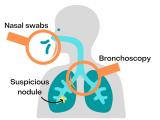A meeting of statistical leads from the seven NCI Community Oncology Research Program (NCORP) Research Bases with statisticians from the Division of Cancer Prevention (DCP) Biometry Research Group took place on July… Learn more
POSTED: 1/20/2022
SOURCE: DCP News

Lung cancer, the leading cause of cancer deaths worldwide killing 1.8 million people each year, is often diagnosed at an advanced stage when the chances for a cure are limited.
In the United States, almost 60… Learn more
In the United States, almost 60… Learn more
POSTED: 1/14/2022
SOURCE: Cancer Prevention Science Blog

